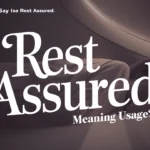When you hear the words cord and chord, do you ever stop and wonder if you’re using them correctly? These two terms are often mixed up, yet they have vastly different meanings and uses. While they may sound the same, their definitions diverge significantly depending on the context.
Whether you’re a musician, a writer, or simply someone who enjoys language, understanding the difference between cord and chord can help clarify your communication and improve your writing skills.
In this comprehensive article, we’ll explore everything you need to know about these two words. From their definitions and uses to examples in daily life, we’ll guide you through the key differences.
By the end of this post, you’ll be confident in your ability to distinguish between a cord and a chord—and use them appropriately.
What Is a ‘Cord’?
The word cord is often used to refer to a long, flexible string or rope-like object. It’s a tangible item that you can touch and use to tie, secure, or connect things. The most common uses of cord include physical materials, cables, and even anatomical references. Let’s break it down further:
Electrical Cord
One of the most common types of cord is the electrical cord, which is used to connect electrical devices to power sources. Think about your laptop’s charging cord or the power cords for your household appliances like toasters, lamps, and phones. These cords are made up of insulated wires that carry electricity from one point to another.
- Example: “I need to grab the power cord for the vacuum cleaner.”
Cord in Furniture and Upholstery
Another place you’ll find the word cord is in furniture or upholstery. Here, it refers to a decorative trim or reinforcing material used to line the edges of furniture such as sofas, chairs, or cushions.
- Example: “The fabric was beautifully designed, with a cord trim along the edges.”
Medical Cord
In medical terminology, cord often refers to a connecting conduit, like the umbilical cord. This is the flexible tube that connects a fetus to the placenta, providing oxygen and nutrients necessary for its development.
- Example: “The cord was cut after the baby was born.”
What Is a ‘Chord’?
On the other hand, chord is a term commonly used in music. A chord refers to a combination of musical notes played simultaneously or in succession. It’s the harmony that arises when certain notes are combined. Unlike cord, which is tangible, chord is more abstract, especially when used in the context of sound and emotion.
Musical Chords
In music theory, a chord typically consists of at least three different notes played at the same time. There are different types of chords—major, minor, diminished, and more—each evoking different emotional responses. For instance, a major chord tends to sound bright and happy, while a minor chord often feels more somber or sad.
- Example: “She played a beautiful chord on the piano, and it resonated with everyone in the room.”
Metaphorical Use of ‘Chord’
Besides its musical use, chord can also have a metaphorical meaning. For example, the phrase “striking a chord” is often used to describe something that resonates deeply with someone on an emotional or intellectual level.
- Example: “His speech really struck a chord with me.”
Chords in Different Musical Contexts
In various musical genres, chords are fundamental in creating harmony and expressing emotions through sound. Whether in classical compositions or modern pop songs, chords shape the structure of music. Understanding chords is essential for both composers and performers alike.
- Example: “The chord progression in that song was incredibly moving.”
Key Differences Between ‘Cord’ and ‘Chord’
While cord and chord are pronounced the same way, their meanings and uses are vastly different. Let’s take a closer look at the key differences between these two terms.
Spelling
The first and most obvious difference between cord and chord is their spelling. A cord has an “r” in it, while a chord has an “h.” This small difference might seem insignificant at first glance, but it’s crucial for understanding the context in which each word should be used.
Pronunciation
Even though they are spelled differently, cord and chord are pronounced the same way. Both words are homophones, meaning they sound identical but have different meanings. This is why it’s important to pay attention to the context in which you encounter these words.
Contextual Differences
Cord is generally used when referring to something physical, like a rope, wire, or string. It’s something you can touch or see in the real world. In contrast, chord is typically used in musical contexts or metaphorically to represent emotional resonance or harmony.
- Example: “I used the cord to tie the box, while the music played a soft chord in the background.”
When to Use ‘Cord’ and When to Use ‘Chord’
Knowing when to use cord versus chord is straightforward once you understand their meanings. Here are some simple rules to help guide your usage:
When to Use ‘Cord’
Use cord when you are talking about something physical like a wire, rope, string, or a similar object. It’s also appropriate to use cord in medical or anatomical references, such as the umbilical cord.
- Example: “Please hand me the extension cord.”
- Example: “I tied the package with a strong cord.”
When to Use ‘Chord’
Use chord when referring to musical terms or when you are discussing emotional resonance. If you are talking about harmony in music or describing something that emotionally “strikes a chord,” use chord.
- Example: “That song’s chord progression was beautiful.”
- Example: “His words really struck a chord with the audience.”
Common Mistakes to Avoid
It’s easy to make mistakes when using cord and chord, especially because they sound identical. Here are some common errors people make and how to avoid them:
Mixing Up ‘Cord’ and ‘Chord’ in Writing
One of the most frequent mistakes people make is using cord when they mean chord or vice versa. This usually happens when someone is writing quickly or doesn’t fully understand the terms.
- Example of a mistake: “I need to plug in the music cord.” (This should be chord since it refers to a musical instrument.)
- Corrected: “I need to plug in the music chord.”
Using ‘Chord’ in a Non-Musical Context
Another mistake is using chord in a non-musical context where chord would be appropriate. For instance, calling a power cord a power chord is incorrect.
- Example of a mistake: “My cord isn’t long enough to reach the outlet.”
- Corrected: “My cord isn’t long enough to reach the outlet.”
Real-World Applications of ‘Cord’ and ‘Chord’
Understanding the real-world applications of these two words can help reinforce their differences and clarify when to use each.
Cord in Everyday Life
Cords are used extensively in everyday life. Whether you’re setting up a new device, tying something down, or dealing with an emergency, you’ll likely encounter a cord in some form.
- Electrical cords: Connecting appliances to power sources.
- Clothing and Accessories: Tying shoes or adjusting clothing.
- Health and Medicine: An umbilical cord is a crucial part of prenatal development.
Chord in Music and Emotion
On the other hand, chords are mostly used in the world of music, but they also hold emotional significance. A single chord can convey deep feelings or set the tone for an entire performance.
- Musical compositions: Composers use chords to create harmony and emotion in their music.
- Emotional connection: A chord can resonate with a listener, evoking feelings of joy, sadness, or nostalgia.
Final Thoughts on Cord vs. Chord
Understanding the difference between cord and chord is essential for clear communication. While both words sound the same, their meanings are distinct and tied to specific contexts.
Whether you’re working with a cord in a technical field or creating music with chords, knowing when to use each term will improve your writing and speaking.
By remembering the basic rules outlined above, you’ll avoid confusion and communicate more effectively.
Frequently Asked Questions (FAQs)
1. What’s the difference between a cord and a chord?
The primary difference lies in their meanings and usage. A cord refers to a physical object, such as a rope, string, or electrical wire. It’s something you can touch and use. A chord, on the other hand, is related to music. It’s a combination of musical notes played together, or it can also refer to emotional resonance when something “strikes a chord” with you.
2. Can I use ‘cord’ when talking about music?
No, if you’re referring to a musical concept, you should use chord. For instance, a musical chord is a combination of notes played simultaneously. A cord would not be appropriate in this context.
- Incorrect: “I need to tune the cord of my guitar.”
- Correct: “I need to tune the chord of my guitar.”
3. What is an example of a ‘cord’ in everyday life?
A cord is used in a variety of everyday situations. Here are a few examples:
- The charging cord for your phone.
- The cord used to pull open a curtain.
- A rope cord used for securing or tying items.
4. Why does ‘cord’ and ‘chord’ sound the same but have different meanings?
Cord and chord are homophones, meaning they sound the same but have different meanings and spellings. This can make them tricky to use, but understanding their respective contexts helps avoid confusion.
5. Can I use ‘chord’ in a non-musical context?
Yes, you can use chord in a metaphorical way. For example, saying that something “struck a chord” with you means it deeply resonated or connected with you emotionally.
- Example: “Her story really struck a chord with me.”
However, chord should still be used in musical contexts when referring to the combination of notes.

Jasper Hunter is a passionate writer and numerology enthusiast dedicated to exploring the profound significance of angel numbers. With a background in spiritual studies and a keen interest in metaphysics, Jasper delves into the mystical meanings behind numbers and how they can guide us in our daily lives.



